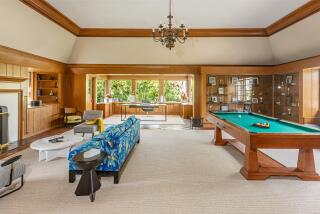Apartment Tower Plans Have Loft District on Edge
From her desk, architecture student Rita Haudenschild has a front-row seat to Los Angeles’ past, present and future.
To her left and right she can see how history has been preserved, patched up and packaged as cutting-edge design in the 97-year-old freight depot that has been turned into the high-tech schoolhouse she sits in.
Outside the wall-size window in front of her desk is a panoramic view of distant downtown high-rise towers that light up at dusk as glittering proof of the city’s vibrancy.
And between the depot and the towers is the dusty vacant field that could become the newest battleground over what the future L.A. will look like.
Haudenschild, 27, is a graduate student at SCI-Arc, the architecture school that for 2 1/2 years has occupied the historic Santa Fe Railroad freight depot southeast of downtown’s Little Tokyo.
The depot building is a local landmark. Built in 1907 to replace a freight center that had burned to the ground, the narrow steel-reinforced structure stretches a quarter-mile along Santa Fe Avenue between 3rd and 4th streets.
But next to the building is an empty lot that for decades has enticed developers.
Roughly forming a triangle west of SCI-Arc, the approximately 15-acre site was a favorite filming spot in the 1980s and early ‘90s
In the mid-’90s the Los Angeles Unified School District designated the lot as the site of a future central warehouse for books, cafeteria food and other school materials.
Artists living in nearby studio lofts created in old factory buildings argued that warehouse truck traffic would choke streets, making it impossible for painters, sculptors and writers to work.
The artist colony was pleased when the property was sold in 1999 and the Southern California Institute of Architecture was persuaded to move in as the tenant of the old depot building.
SCI-Arc leaders talked of turning the empty lot into an eclectic mix of housing, restaurants and student parking -- all designed with cutting-edge, adventuresome architecture.
But SCI-Arc is an independent, nonprofit school that basically operates on the $17,450 yearly tuition paid by each of its 450 students. Securing funding to buy the refurbished depot and the adjoining empty lot took longer than school officials expected.
Still, institute administrators said there was shock and dismay last month when they learned that their landlord had sold the vacant lot -- which consists of three parcels -- to apartment developers.
Word was that the new owners were considering building a pair of 40-story towers, each with 384 luxury apartment units.
“If this school is to grow, we need the capacity to expand,” said Haudenschild as she gazed toward a Los Angeles skyline that she fears might someday be hidden by apartments.
“Downtown seems to be changing a lot. Being down here and seeing it offers such a wealth of information and influence to us as students. You see how each of the different elements interact and can influence the way you think about design.”
A few work spaces away, freshman architecture student Bryan Birchard, 25, was wondering what kind of effect luxury apartments would have on the rough-edged studio lofts that partially encircle SCI-Arc. Some of his fellow students live in the converted industrial space.
Developers Richard Meruelo and Daniel D. Villanueva could not be reached for comment this week. But others had plenty to say about the potential interaction of elements, as Haudenschild put it.
Loft district leader Tim Keating said proper development of the parcels is crucial to the artist colony and to downtown as a whole.
“It’s both the neighborhood and the school perspective that we want world-class architecture built there. You have a triangle there that could be a town center,” said Keating, an artist and movie prop maker who heads the Los Angeles River Artist and Business Assn. and is a member of downtown’s Historic Cultural Neighborhood Council.
Eric Owen Moss, an architect who serves as director of SCI-Arc, said such a center was envisioned by school leaders as they sought funding to buy the lot.
“We wanted to make something that was truly an amalgamation of neighborhood interests, including the concerns that SCI-Arc had of taking care of its own people,” Moss said.
When it became clear that the school could not raise the approximately $25 million needed to buy the depot building and the parcels comprising the empty lot, officials sought to buy the building and one of the parcels “and work with the developer to develop parks, housing and parking” on the other two parcels, Moss said.
“We offered an acceptable price” -- $15 million -- for the building and the single parcel. But Meruelo and Villanueva offered $12.5 million for the entire empty lot, and a deal was struck, Moss said.
SCI-Arc landlord Ken Jackson of Dynamic Builders said all three parcels of the empty lot were in escrow to Meruelo and Villanueva when institute officials approached him. He would not speculate whether the developers might be willing to sell a parcel to the school for use as student housing or parking.
Jackson said an apartment project at the site would help complete the area’s transition from industrial to loft/residential.
“It’s a cool, neat area. I would hope that our buyers are capable of taking it to its final development level,” Jackson said.
L.A. officials, meantime, are watching the vacant lot with interest.
City Councilwoman Jan Perry said she planned to summon Meruelo and Villanueva to a meeting to discuss their plans. So far, they have not applied for any building permits.
Perry said density, effect on traffic and “where they’re headed architecturally with this” are some of the issues that need defining.
“That is an architecturally demanding community. I’m going to work to make sure that whatever they want to put there is compatible with SCI-Arc,” Perry said.
For now, she said, “If SCI-Arc has the money to buy that third parcel, I’d suggest they be aggressive about acquiring it.”
Like neighborhood leader Keating, SCI-Arc’s Moss said he was optimistic that things could be worked out among the school, the developers and Jackson.
But “if ultimately SCI-Arc and the architecture community is confronted with a project that is not palatable and, in fact, is a reflection of something that is utterly antithetical to what SCI-Arc has always stood for, at that point we have to go somewhere else,” Moss said.
For now, though, the school has seven more years on its $88,000-per-month-lease on the depot building.
And that means that Haudenschild and her fellow students could be receiving some riveting lessons about real-life urban design.







